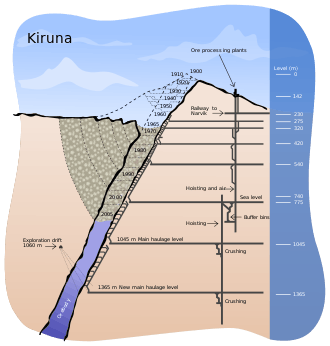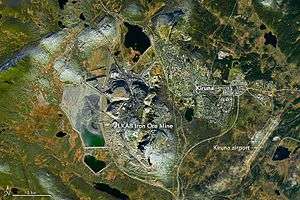Kiruna Mine
|
Kiruna Mine and townsite from ISS, 2016 | |
| Location | |
|---|---|
 Kiruna mine Location in Sweden | |
| Location | Kiruna |
| Municipality | Lapland |
| Country | Sweden |
| Coordinates | 67°51′01″N 020°11′34″E / 67.85028°N 20.19278°ECoordinates: 67°51′01″N 020°11′34″E / 67.85028°N 20.19278°E |
| Production | |
| Products | Iron ore |
| Production | 27,500,000 tonnes of iron ore |
| Financial year | 2008 |
| History | |
| Opened | 1898 |
| Owner | |
| Company | Luossavaara-Kiirunavaara AB |
The Kiruna mine is the largest and most modern underground iron ore mine in the world.[1] The mine is located in Kiruna in Norrbotten County, Lapland.[1] The mine which is owned by Luossavaara-Kiirunavaara AB, a large Swedish mining company, has an annual production capacity of over 26 million tonnes of iron ore.[2] In 2008 the mine produced 27.5 million tonnes of iron ore.[1] The Kiruna mine has an ore body which is 4 kilometres (2.5 mi) long, 80 metres (260 ft) to 120 metres (390 ft) thick and reaching a depth of up to 2 kilometres (1.2 mi). Since mining began at the site in 1898, the mine has produced over 950 million tonnes of ore.[1]
History
The Kiruna orebody was formed following intense volcanic activity. Iron-rich solutions precipitated the iron on to a syenite porphyry footwall.[3] Then the ore bed was covered by further volcanic deposits, quartz porphyry, and sedimentary rocks. Later the whole body was tilted to its current dip of 50 to 60°. Having a grading of more than 60% iron and an average of 0,9% phosphorus, the ore contains a very pure magnetite-apatite mix.[3]
.jpg)
The original reserve of the Kiruna mine was around 1.8 billion tonnes of ore.[1] In the beginning, surface mining was used, but the mine has been mined with the sublevel caving mining method since the 1960s. As of 2008 the Kiruna mine had estimated proven reserves of approximately 602 million tonnes grading 48.5% iron with probable reserves of 82 million tonnes grading 46.7% iron.[1] Measured, indicated and inferred resources add a further 328 million tonnes to the proven reserves. Until 1999 the deepest level of the mine reached 775 metres (2,543 ft), but after 1999 the new level went deeper reaching a depth of 1,045 metres (3,428 ft).[1] The 1,045 metres (3,428 ft) level can support current iron ore production until 2018. On October 28, 2008 Luossavaara-Kiirunavaara AB decided to go even deeper, the new level reaching a depth of 1,365 metres (4,478 ft) to be finished by 2012 at a cost of US$1.7 billion.[1]

See also
References
External links
| Wikimedia Commons has media related to Kiruna iron mine. |

